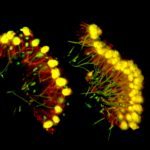Link to Pubmed [PMID] – 35504284
Link to HAL – pasteur-04157790
Link to DOI – 10.1016/j.cub.2022.04.017
Curr Biol 2022 Jun; 32(11): 2539-2547.e5
Although signaling by the gaseous molecule nitric oxide (NO) regulates key physiological processes in animals, including contractility,1-3 immunity,4,5 development,6-9 and locomotion,10,11 the early evolution of animal NO signaling remains unclear. To reconstruct the role of NO in the animal stem lineage, we set out to study NO signaling in choanoflagellates, the closest living relatives of animals.12 In animals, NO produced by the nitric oxide synthase (NOS) canonically signals through cGMP by activating soluble guanylate cyclases (sGCs).13,14 We surveyed the distribution of the NO signaling pathway components across the diversity of choanoflagellates and found three species that express NOS (of either bacterial or eukaryotic origin), sGCs, and downstream genes previously shown to be involved in the NO/cGMP pathway. One of the species coexpressing sGCs and a bacterial-type NOS, Choanoeca flexa, forms multicellular sheets that undergo collective contractions controlled by cGMP.15 We found that treatment with NO induces cGMP synthesis and contraction in C. flexa. Biochemical assays show that NO directly binds C. flexa sGC1 and stimulates its cyclase activity. The NO/cGMP pathway acts independently from other inducers of C. flexa contraction, including mechanical stimuli and heat, but sGC activity is required for contractions induced by light-to-dark transitions. The output of NO signaling in C. flexa-contractions resulting in a switch from feeding to swimming-resembles the effect of NO in sponges1-3 and cnidarians,11,16,17 where it interrupts feeding and activates contractility. These data provide insights into the biology of the first animals and the evolution of NO signaling.

